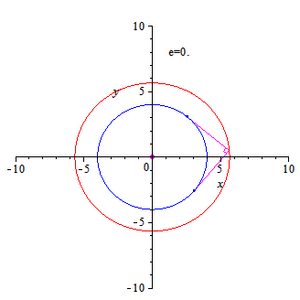Locus (mathematics) facts for kids
In geometry, a locus (pronounced LOW-cuss; the plural is loci, pronounced LOW-sigh) is a collection of points. These points all share a special rule or condition. When you connect these points, they usually form a curve or a surface.
For example, imagine all the points in a flat surface that are exactly the same distance from a central point. If you draw all these points, you will get a circle. This means a circle is a locus of points!
Contents
What is a Locus in Geometry?
A locus helps us describe shapes and paths using rules. It's like a treasure map where the "treasure" is every point that fits a certain description.
Understanding the Basic Idea
Think of a single point moving according to a specific rule. The path it draws is its locus.
- A point might have to stay a certain distance from another point.
- It might have to be equally far from two different lines.
- Or it could be equally far from two other points.
The word "locus" comes from Latin and means "place" or "location." In math, it's about finding all the places where a rule is true.
Common Examples of Loci
Many common geometric shapes can be described as loci. Understanding these helps you see how simple rules create complex figures.
Locus of a Circle
A circle is perhaps the easiest locus to understand.
- Rule: All points that are a fixed distance (called the radius) from a central point.
- Example: If you tie a rope to a pole and walk around, keeping the rope tight, your feet trace a circle. Every point your foot touches is the same distance from the pole.
Locus of a Perpendicular Bisector
Imagine two distinct points, A and B.
- Rule: All points that are equally distant from point A and point B.
- Result: This locus forms a straight line. This line is the perpendicular bisector of the line segment connecting A and B. It cuts the segment exactly in half and at a 90-degree angle.
Locus of an Angle Bisector
Consider two lines that cross each other, forming an angle.
- Rule: All points that are equally distant from both of these intersecting lines.
- Result: This locus forms another straight line. This line is the angle bisector, which divides the original angle into two equal smaller angles.
Locus of Parallel Lines
Think about a single straight line.
- Rule: All points that are a fixed distance from this line.
- Result: This locus forms two lines that are parallel to the original line, one on each side.
Why are Loci Important?
Loci are not just abstract ideas; they are very useful in many areas.
- Engineering: Engineers use loci to design parts that move in specific ways. For example, the path a robot arm takes can be described as a locus.
- Computer Graphics: In video games and animation, understanding loci helps create realistic movements and shapes.
- Navigation: When you use GPS, the system often calculates your position based on distances from satellites, which involves locus principles.
- Architecture: Architects might use loci to design curved structures or to figure out the best placement for elements based on distance rules.
Loci help us describe and understand the world around us in terms of shapes and movements.
See also
 In Spanish: Lugar geométrico para niños
In Spanish: Lugar geométrico para niños


